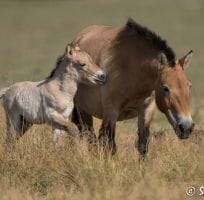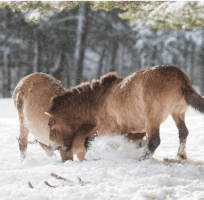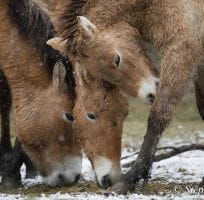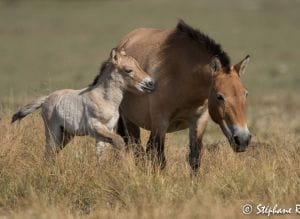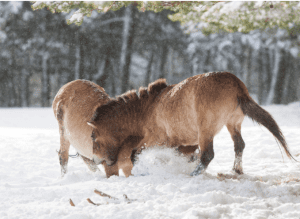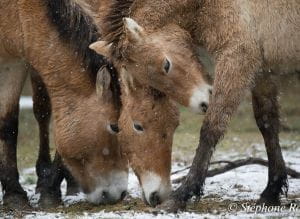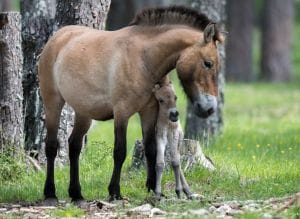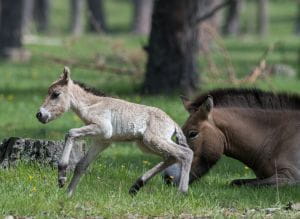Prehistoric wild horse
Equus ferus przewalskii or Equus caballus przewalskii
This wild horse is characterized by a short, stiff mane that sheds every year. Its coat is always isabella, often with darker bracelets around the legs. A dark mullet stripe systematically highlights the spine. The belly of this prehistoric horse is white.
These little wild horses weighing in at around 300 kilos are pretty damn hardy: native to the steppe and semi-deserts, they make do with a frugal diet and know how to withstand extreme temperatures.
A little coquetry on the part of this wild horse, known colloquially as the Mongolian horse, it has two more chromosomes than the domestic horse: 66 as opposed to 64. Yet this does not prevent it from being genetically very similar.
As a result, Przewalski’s horse and the domestic Mongolian horse are inter-fertile, producing fertile foals. Different species or same species? The controversy rages on and promises to last even if very recent research (Ludovic Orlando – CNRS Toulouse April 2018) seems to point to a different origin from that imagined until now.
The Kingdom of Przewalski’s horseAn ignored species
Once upon a time, Przewalski’s Horse ruled all of Europe and much of Asia. Prehistoric man left 610 representations of wild horses in the decorated caves of France, Italy and Spain. The oldest date back 30,000 years, and the most recent 9,000 years.
In modern times, it is becoming increasingly rare. So much so that the great Linnaeus ignored it in his encyclopedia of species.
However, up until the end of the 18th century, herds of wild horses were still reported in a vast area between Germany and northern China. But, very quickly, the species began an unstoppable decline.
In Europe, the last prehistoric horse was probably killed in 1814, on the East German side. In Asia, the Mongolian horse died out more slowly. A few rare herds of wild horses were still to be seen in Mongolia and Xinjian at the very beginning of the twentieth century.
In 1878, at the Sino-Russian border post of Zaisan, Colonel Nikolai Mikhailovich Przewalsky, the great Russian explorer, received a gift from the local authorities: a horse skull and hide. He had them taken to the Zoological Museum of the St Petersburg Academy of Sciences.
After studying them, the curator concluded to the existence of a wild horse, which was given the scientific name of “Equus przewalski Poliakov 1881”. It was then that Westerners discovered Przewalski’s Horse.
A vanishing wildvictim of its success
As news of Przewalski’s horse spread throughout Western Europe, many zoos and private parks were eager to acquire one. From 1897 onwards, several capture campaigns were organized. The most successful of these, in 1901, resulted in the capture of 52 foals after the adults, too fast and too wary, had been slaughtered. Only 28 of these foals made it to Europe alive.
These campaigns were a disaster for the species, ultimately providing only 11 individuals capable of breeding. Together with a Mongolian pony joined in 1906 and a mare captured in the wild in 1947, they are at the origin of today’s wild horse population.
The last wild Przewalski’s Horse was observed in 1968 in the Gobi Desert, Mongolia.
For several decades, the descendants of these 13 wild horses languished in zoos and parks, having lost all their wild culture. Today, they number around 1,500. Some twenty years ago, three associations were formed to try and reintroduce this prehistoric horse to Mongolia.
The NGO International Takhi Group released 90 horses between 1992 and 2004 after re-education for life in the wild. The NGO Foundation for the preservation of nature and environment released 84 individuals in another region of Mongolia. Finally, the Takh association created by Swiss ethologist Claudia Feh, based in the Cévennes region of France, transferred 22 horses, again to Mongolia, in 2004 and 2005.
Seven of the Przewalski’s horses in our Reserve come from Takh’s herds. Today, around 350 Przewalski horses have thus returned to a wild, free life, not counting those in the Monts d’Azur Biological Reserve.
Information from IUCN: go see
A difficult integrationwithin the reserve
The Reserve’s Przewalski’s Horses come from Prague Zoo (3 mares), Gramat Zoo and Domaine du Villaret (Lozère) managed by the Association Takh. On their arrival, in November 2005 and June 2006, the first two groups of Przewalski’s Horses seemed lost, unable to find their place in this vast space, which was also populated by other animals. Their relationship with other species, the European Bison in particular, was abysmal, permanently conflicting.
This is the first time I’ve seen a group of Przewalski’s Horses.
Fooda hardy horse
Food-wise, Przewalski’s Horse grazes the Reserve’s grass and legume meadows, much more rarely the undergrowth. Trees (Scots pine) and shrubs are eaten only incidentally, even in winter, when this prehistoric horse is able to cope with low rations. During the breeding season, from April to June, stallions lose a great deal of weight, which is taken up by the group of females they try to keep in close proximity. Unlike bison, family groups live year-round under the guidance of a stallion. Births take place 11 months later.
EndangeredSEVEN SPECIES OF WILD HORSE IN THE WORLD
There are only seven species of wild horse in the world, including Przewalski’s Horse : Plains zebra (equus burchellii), Grevy’s zebra (equus grevyi), mountain zebra (equus zebra) and African wild ass (equus africanus) are still found in Africa, while Asian wild ass (equus hemonius) and Kiang (equus kiang) are found in Turkmenistan and Mongolia.
birthsthe family grows
Until 2008, we had only registered one Mongolian horse birth probably due to the failure of the dominant stallion. It was therefore necessary to introduce new males. This we did in June 2009, thanks to the invaluable help of the Takh association.
As soon as they arrived, the six new Przewalski Horses, three males and three females, joined the existing group. After a few difficult days, a group of ten horses was formed including two newcomer stallions and the eight females from the reserve.
Over the years, the constitution and number of family groups varies, increasing the genetic variability of the foals.
Since 2014, 3 distinct groups have shared the territory. The largest (dubbed the grand harem), made up of around 15 individuals, occupies a strategic position near the large lake, while the small harem (4 to 5 individuals) remains confined to a poorer wooded meadow to the west of the Reserve. As for the group of single males, they tend to roam the upper reaches, regularly attempting incursions into the territory of the large harem, inevitably provoking the wrath of the “dominant” stallion.
